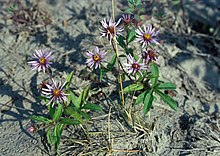Eurybia (plant)
| Eurybia | |
|---|---|
 |
|
| Eurybia sibirica | |
| Scientific classification | |
| Kingdom: | Plantae |
| (unranked): | Angiosperms |
| (unranked): | Eudicots |
| (unranked): | Asterids |
| Order: | Asterales |
| Family: | Asteraceae |
| Tribe: | Astereae |
| Genus: |
Eurybia (Cass.) S.F.Gray |
| Synonyms | |
|
|
Eurybia is a genus of plants in the composite family that were previously included in the genus Aster. All species are native to North America, though some are also present in northern Eurasia. There are 23 species in the genus including 1 hybrid. The name was first applied by Alexandre de Cassini in 1820. The name is derived from Ancient Greek ευρυς (eurys), meaning wide, and βαιος (baios), meaning few, perhaps in reference to the small number of relatively wide ray florets.
All species within the genus are perennials that grow from 10 to 120 cm in height. They have rhizomes which can either be long, slender or short and thick or sometimes cormoid, all of which often become woody. The stems can be ascending to erect and are typically simple, though they are in rare cases they branch proximally, i.e. near the point of attachment. They can be glabrous to more or less densely hairy, and are generally eglandular, meaning they lack glands, though they can sometimes be stipitate-glandular, meaning glands are present on a stipe.
The leaves are always alternate. Both basal and cauline leaves, i.e. leaves growing on the stem, are present, and these may be either sessile or petiolate, meaning lacking or having a leaf stalk. The blades of the leaves may be anything from cordate, ovate, obovate, elliptic, or oblong in shape to spatulate, oblanceolate, or lanceolate. They are usually gradually reduced distally, meaning they taper towards the apex. The leaf margins can be entire or serrate, i.e. toothed, though they may also occasionally be spinulose-serrate, that is being toothed with small spines. The leaf surfaces are glabrate to hairy and are usually eglandular, though they may sometimes be stipitate-glandular.
The capitula, or flower heads, are radiate and typically appear in corymbiform arrays, but in rare cases they may be borne singly. The involucres, the bracts at the base of the flower heads, are cylindro-campanulate, meaning bell-shaped, to broadly campanulate and measure from 4 to 14 and exceptionally to 16 mm long by 4 to more than 25 mm wide. The phyllaries, that is the individual bracts that make up the involucres, number from 20 up to 140 in 3 to 7 series and are single nerved. They are usually rounded adaxially, i.e. towards their upper-side, but are sometimes low-keeled. Their shape is unequal and broadly ovate or oblong to oblanceolate, lanceolate, or linear. The bases of the phyllaries are indurate, or hardened, and rarely wholly foliaceous, meaning leaf-like in appearance. Their margins are narrowly scarious, meaning membranous and dry, or occasionally herbaceous, and often ciliolate, i.e. having minute cilia. The apices, or terminal ends, are obtuse to acute, while the surfaces are glabrous (hairless), somewhat strigillose (with stiff, slender bristles), puberulent (very finely haired), scabrellous (having small rough hairs), strigoso-villous (with stiff soft hairs), or villous (having soft shaggy hairs), and occasionally they are more or less stipitate-glandular.
...
Wikipedia
